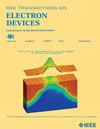Stack Optimization of TiOx-Based Resistive Switching Devices Through Interface Engineering
IF 2.9
2区 工程技术
Q2 ENGINEERING, ELECTRICAL & ELECTRONIC
引用次数: 0
Abstract
Metal-oxide-based resistive switching random access memory (RRAM) is a promising candidate for next-generation embedded memory due to its simple structure, fast switching speed, and compatibility with CMOS fabrication processes. To enhance its compute density and reduce power consumption, integrating RRAM devices into advanced technology nodes is crucial, necessitating the scaling down of device area and operational voltage. This study explores the influence of bottom TiN electrodes with varying growth conditions, revealing a strong correlation between forming voltage and nitrogen concentration in TiN. In addition, the relationship between forming voltage and high-resistance state (HRS) resistance is examined, showing that lower forming voltages result in higher HRS resistance. Nitrogen plasma treatment of both bottom and top electrode interfaces effectively reduces forming voltage without compromising HRS resistance. These findings provide guidelines for optimizing TiOx-based RRAM devices for compute-in-memory (CIM) applications and can be generalized to similar metal-oxide-based RRAM devices.基于接口工程的tiox基阻性开关器件的堆栈优化
基于金属氧化物的电阻开关随机存取存储器(RRAM)由于其结构简单、开关速度快以及与CMOS制造工艺的兼容性,是下一代嵌入式存储器的有前途的候选者。为了提高其计算密度和降低功耗,将RRAM器件集成到先进的技术节点中至关重要,这就需要缩小器件面积和工作电压。本研究探讨了不同生长条件下底部TiN电极的影响,揭示了形成电压与TiN中氮浓度之间的强相关性。此外,研究了成形电压与高阻状态电阻之间的关系,表明成形电压越低,高阻状态电阻越高。底部和顶部电极界面的氮等离子体处理有效地降低了成形电压,而不影响HRS电阻。这些发现为优化内存中计算(CIM)应用的基于tiox的RRAM器件提供了指导方针,并且可以推广到类似的基于金属氧化物的RRAM器件。
本文章由计算机程序翻译,如有差异,请以英文原文为准。
求助全文
约1分钟内获得全文
求助全文
来源期刊

IEEE Transactions on Electron Devices
工程技术-工程:电子与电气
CiteScore
5.80
自引率
16.10%
发文量
937
审稿时长
3.8 months
期刊介绍:
IEEE Transactions on Electron Devices publishes original and significant contributions relating to the theory, modeling, design, performance and reliability of electron and ion integrated circuit devices and interconnects, involving insulators, metals, organic materials, micro-plasmas, semiconductors, quantum-effect structures, vacuum devices, and emerging materials with applications in bioelectronics, biomedical electronics, computation, communications, displays, microelectromechanics, imaging, micro-actuators, nanoelectronics, optoelectronics, photovoltaics, power ICs and micro-sensors. Tutorial and review papers on these subjects are also published and occasional special issues appear to present a collection of papers which treat particular areas in more depth and breadth.
 求助内容:
求助内容: 应助结果提醒方式:
应助结果提醒方式:


